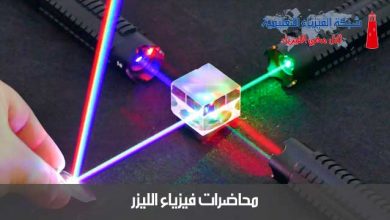محاضرة 16 فيزياء الليزر انظمة الليزر ليزر الهيليوم نيون
ليزر الهيليوم نيون Helium-Neon Laser
في المحاضرات السابقة درسنا الليزر فكرة عمل الليزر بشكل عام مع التركيز على العوامل المؤثرة على الليزر. والآن سوف نخصص دراستنا على عدة انظمة لليزر تختلف باختلاف المادة Active medium ويمكن تقسيم انظمة الليزر إلى خمسة اقسام هي على النحو التالي:-
-
The state of matter of the active medium: solid, liquid, gas, or plasma.
اعلانات جوجل -
The spectral range of the laser wavelength: visible spectrum, Infra-Red (IR) spectrum, etc.
-
The excitation (pumping) method of the active medium: Optic pumping, Electric pumping, etc.
-
The characteristics of the radiation emitted from the laser.
-
The number of energy levels which participate in the lasing process.
اعلانات جوجل
سوف نعتمد على النوع الاول والذي يقسم الليزر حسب المادة Active medium والذي يحدد الخواص التالية:
-
Laser Wavelength.
-
Preferred pumping method.
-
Order of magnitude of the laser output.
-
The efficiency of the laser system.
اعلانات جوجل
We saw that the two basic requirements for laser action are:
-
Population Inversion between the upper and lower laser energy levels.
-
The active medium must be transparent to the output wavelength.
تجدر الاشارة هنا إلى ان active medium هي التي تحدد خواص الليزر ولهذا السبب تعود تسمية الليزر حسب المادة المستخدمة.
Laser types
| [1] Gas lasers:
Krypton Laser (Kr+).
Chemical Laser.
[2] Solid State lasers:
Alexandrite Laser.
[3] Diode Laser (Semiconductor Laser, Injection Laser). [4] Dye Laser (Liquid). [5] Special Lasers:
|
Helium-Neon (He-Ne) Laser
The Helium-Neon laser was the most common laser until the spread of diode lasersin the last few years. It was first built in 1961 by Ali Javan. The active medium is a noble gas Neon (Ne), and it is a 4 level laser.
The energy level diagram of a Helium-Neon laser is described in the figure below.
Two meta-stable energy levels act as upper laser levels. The He-Ne laser have two lower laser levels, so quite a few wavelengths can come out of the transitions between these levels.
The important wavelengths are:
λ1= (632.8 [nm]), λ2=1.152 [mm], λ3=3.3913 [mm],

Energy Level Diagram of He-Ne Laser
The role of the Helium gas in He-Ne laser is to increase the efficiency of the lasing process. Two effects make Helium particularly valuable:
-
The direct excitation of Neon gas is inefficient, but the direct excitation of He gas atoms is very efficient.
-
An excited state of the He atom (labeled E5) has an energy level which is very similar to the energy of an excited state of the Neon atom (also labeled E5).
The excitation process of the Neon atoms is a two stages process:
-
The high voltage causes electrons to accelerate from the cathode toward the anode. These electrons collide with the He atoms and transfer kinetic energy to them.
-
The excited Helium atoms collide with the Neon atoms, and transfer to them the energy for excitation.
Thus Helium gas does not participate in the lasing process, but increases the excitation efficiency
Red Wavelength out of He-Ne Laser
Most of the applications of He-Ne Laser use the red wavelength, because it is the strongest line and it is in the visible region of the spectrum.
As shown in figure above, this red light is emitted when the Neon atom goes from the energy level labeled E5 to the energy level labeled E2, a much bigger energy difference than for the other transitions.
A problem with creating this red light is that a Neon atom in state E5 may also emit 3.3913 [mm] radiation. This emission decreases the population of the E5 level, without producing visible radiation.
The solution to this problem is to use a special coating on the laser mirrors which selectively reflect only the red light. This coating causes reflection back into the optical cavity of only the desired (red) wavelength, while all other wavelengths are transmitted out, and not forced to move back and force through the active medium.
In a similar way, other selective reflecting coating can be used on the mirrors to select other transitions. This procedure allows commercial production of He-Ne lasers at other wavelengths in the visible spectrum. For example, orange, yellow and green He-Ne lasers can be produced, but the laser efficiency is much lower than for the red.
Absorption and Amplification in He-Ne Laser
He-Ne laser is a 4 level laser, so the lifetime of the lower laser energy level needs to be very short. In a Neon gas, which is the active lasing gas, the transition (decay) from the lower laser level is not fast enough, but it is accelerated by collisions with the tube walls. Because the number of collisions with the tube walls increase as the tube becomes narrow, the laser gain is inversely proportional to the tube radius. So, the tube diameter of a He-Ne laser must be as small as possible.
The low gain of the active medium in a He-Ne laser limits the output power to low power. In laboratory prototypes an output power of the order of 100 [mW] was achieved, but commercial lasers are available only in the output range of 0.5-50 milliwatts [mW].
The output coupler of He-Ne laser is a mirror with coating that transmits about 1% of the radiation to the output. This means that the power inside the optical cavity is a 100 times more than the emitted power
Commercial He-Ne Lasers:
| Wavelength: | 632.8 [nm] |
| Output Power: | 0.5-50 [mW] |
| Beam Diameter: | 0.5-2.0 [mm] |
| Beam Divergence: | 0.5-3 [mRad] |
| Coherence Length: | 0.1-2 [m] |
| Power Stability: | 5 [%/Hr] |
| Lifetime: | >20,000 [Hours] |



